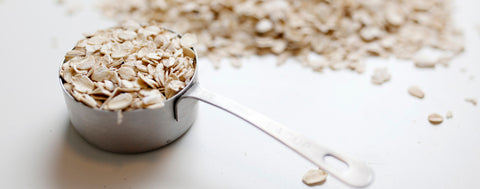Prebiotics are abundant in fresh fruits, vegetables and legumes, however, their content varies widely. Some of the richest sources include chicory root, Jerusalem artichoke and dandelion greens.
Cooking can significantly reduce prebiotic content, whilst drying (as in the case of raw garlic and onion) can significantly increase it.
Most of the foods I have selected here are lower in prebiotic content – though I believe daily consumption of low to moderate sources of this beneficial fibre is a far more comfortable way to get your quota. For example, a huge amount of chicory root in one sitting might make for quite a bloated and gassy gut! The foods on this list are all readily accessible – depending on the season. They make a great starting point, however, remember that diversity is key!
Literature suggests the ideal daily dosage of prebiotics is 10g/day, with dosages less than 3g/day unlikely to stimulate the growth of beneficial lactic acid bacteria. Americans seem to be consuming prebiotics in the 1-4g/day range. Interestingly, inflammatory bowel disease develops in parts of the world where daily intake of prebiotic fibre is low.
Oats
Oats are my absolute favourite functional food. They contain the soluble prebiotic fibre beta-glucan, and have been shown in studies to improve the growth, viability and colonisation of probiotics. Beta-glucans favourably alter lipid profiles, lowering bad ‘LDL’ cholesterol, therefore reducing the risk of heart disease.
Studies are suggestive of beta-glucans having an anti-carcinogenic effect, indicating a protective effect against bowel cancer. Additionally, they are known to stimulate the immune system, increasing resistance to bacterial, viral, fungal and parasitic infections.
Other sources of beta-glucans include barley, mushrooms and yeast.
Legumes
Legumes (beans, peas, lentils, soybeans) contain prebiotic galacto-oligosaccharides (GOS), raffinose-family oligosaccharides (ROS) and resistant starch. A recent study found that the GOS extracted from legumes (dose-dependently) significantly increased beneficial bifidobacteria count (without digestive discomfort such as bloating), and reduced appetite, food intake and inflammation in overweight adults.
I like to cook legumes with carminative spices such as fennel, ginger or cumin to help avoid boating. The other natural source of GOS is milk – breast milk, and mammalian milk.
As a side note, I adore legumes as they are one of the most sustainable protein sources. Animal protein sources have the greatest ecological impact – beef being the largest, followed by pork and chicken. The estimated global land use of beef and veal per kilogram of product is between 7 and 420m2, with 9-129 CO2 equivalents per kilogram, whilst legumes sit between 3-8m2 per kilogram of product, with 1-2 CO2 equivalents/kg.
Legumes are also great nitrogen fixers, helping to improve the health and quality of the soil and promote plant growth (plants absorb nitrogen via their roots and use it to synthesize proteins). For this reason, it is often used in crop rotation to fertilise the soil and consequently contribute to higher yields.
Asparagus
Asparagus, best consumed fresh and raw or lightly steamed, contain FOS and inulin. A review of studies found inulin may contribute to weight loss via an increase of satiety and reduction in energy intake.
A species of wild asparagus called Asparagus racemosus – known as Shatavari in Ayurvedic Medicine, has been used traditionally for digestive complaints such as diarrhoea and dysentery, stomach ulcers and hyperacidity.
Asparagus is also a great source of protein and minerals. It is quick to perish so best stored in the fridge with the ends wrapped in a damp paper towel.
Garlic, Onion and Leeks
Garlic, onions and leeks are all in the allium family of vegetables and have similar health benefits. All three contain both FOS and inulin. Raw garlic is approximately 13% FOS by fresh weight, raw onions are approximately 4%, and leeks approximately 3%. Raw, dried garlic and onion have greater concentrations of prebiotics.
If you crush or chew raw garlic, the compound allicin (responsible for garlic’s renowned antimicrobial properties) becomes enzymatically activated. Garlic has been shown to stimulate the growth of Bifidobacteria and promote a low (acidic) pH environment in the colon, which is favourable for beneficial bacteria.
Artichokes
Both Jerusalem and globe artichokes are great sources of prebiotic fibre, particularly inulin. Jerusalem artichokes have a short season during late autumn and winter, whilst globe artichokes are available through summer. Jerusalem artichokes (18% inulin by weight) contain significantly more prebiotic fibre than globe’s (4% inulin by weight). However, there is still enough inulin in globe artichokes to have a positive effect on gut health.
Bananas
Under-ripe bananas contain prebiotics in the form of resistant starch, however, resistance starch content decreases as the fruit ripens. Upon reaching the colon, it is fermented by bacteria to produce short-chain fatty acids, which provide fuel for the cells of the intestine wall, in turn promoting colon health.
There is some evidence to suggest that resistant starch may improve glycaemic control and insulin response, be used in the management of constipation, diarrhoea, and other gastrointestinal disorders, improve blood lipids and lower risk of cardiovascular disease, promote mineral absorption, and play a role in weight loss by increasing satiety.
An easy way to include slightly green bananas in the diet is to add them to a smoothie. You can even buy green banana flour now, which could be taken daily for its prebiotic effects or used as an alternative to other starches in baking.
Different types of resistant starch can also be found in foods such as legumes, cooked and cooled potatoes, yacon root and teff.
Apples
Apples contain a soluble fibre called pectin, which isn’t as well researched as FOS, inulin and GOS for its prebiotic effects. A recent study found pectin isolated from various fruits (such as wild banana, sweet lemon, watermelon, tomatoes and guavas) enhanced the growth of lactic acid bacteria (lactobacillus spp and bifidobacteria spp).
An animal feeding study found that apple pectin promoted the growth of beneficial bacteria, significantly increased production of the short-chain fatty acid butyrate, and significantly decreased the population of species in the Bacteroidetes group. Bacteroides are normally commensal in the gut flora, however, they can be responsible for infections with significant mortality. They are also among the most antibiotic-resistant of all anaerobic pathogens.
Finally, although raw, unpasteurized apple cider vinegar has been touted as a health wonder drink and source of prebiotics, I can’t find any evidence in support of this.
Worth a mention
Chicory root and raw dandelion greens are particularly rich sources of prebiotic fibres (in fact, chicory is the richest source of inulin, with 40g per 100g). I excluded them from my list only because they are a bit less accessible. You will find chicory root sold as a powered coffee alternative, as it has a very similar taste when roasted. It is also available as a supplement. Dandelion greens can be foraged – even from your own garden should you let it become a little wild. They are great in salads or smoothies.
Written by Lauren Glucina, the naturopath & nutritionist from AscensionKitchen.com, and also the creator of the amazing Lively Desserts.



